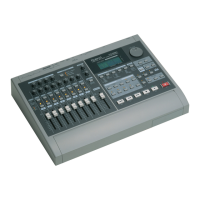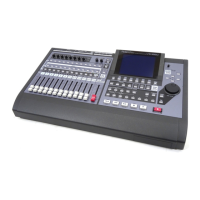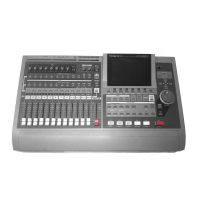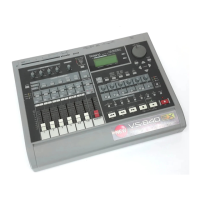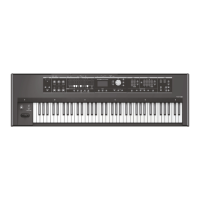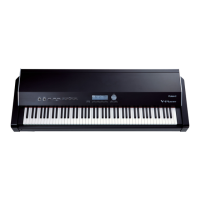25—Harmony
Roland VS-2000 Owner’s Manual www.RolandUS.com 339
Editing a Harmony Sequence
1. On the HARMONY ALGORITHM VIEW screen, press F5 (MICRO)—the
HARMONY MICRO EDIT screen appears.
On this screen, you can edit your Harmony sequence in detail.
2. At the bottom of the screen, set TIME to display the project location in:
•
TIME
—so Harmony events are identified by their clock-time location in the
project.
•
MBT
—so Harmony events are identified by their “Measure, Beat and Tick”
location.
3. Set LIST to display the type of Harmony data you’d like to see. You can select Note,
PBend (for “Pitch Bend”), VbSw (for “Vibrato Switch”), VbRt (for “Vibrato Rate”),
VbDt (for “Vibrato Detune”), VbDp (for “Vibrato Depth”), VbDl (for “Vibrato
Delay”), PtSw (for “Part Switch”), PtTm (for “Part Time”), Frm1-6 (for “Formant 1-6”)
and/or All. To display an item select it and press ENTER/YES to checkmark it.
4. To display the source track’s waveform, press F1 (WAVE) so its darkened.
5. Set Solo to:
•
Off
—all channels play normally.
•
On
—only the harmonies and source track are heard.
6. To edit an already sequenced note, turn the TIME/VALUE dial to highlight it in the
event list at the top of the screen and press ENTER/YES.
7. Press
or
to highlight the setting you wish to change, and turn the Time/Value
dial to select the desired value.
8. To preview the selected event, press F2 (LISTEN).
9. To add a new event, set the CREATE parameter to the type of event you’d like to
add, and then press F3 (CREATE). Edit the new event as desired.
10. To erase the selected event, press F4 (DELETE).
11. To reverse your last edit, press F5 (UNDO). To change your mind, press F5 (REDO).
Harmony Snapshots
You can easily take “Harmony snapshots” of important current Harmony module
settings at the now line’s current location. When the project plays, the settings are
applied, changing the Harmony sound at that location in the project. You can capture
the following current settings individually:
•Portamento switch and time • Vibrato switch, rate, detune, depth and delay
•Formant settings 1-6
For a note in the list, Val1 is the note number and Val2 its velocity, or the force with
which the note plays.
Event list
The selected data
appears here, along with
the source track’s
waveform when WAVE is
turned on. For enhanced
responsiveness, leave
WAVE turned off.
VS2000OMUS.book 339 ページ 2004年10月20日 水曜日 午後3時3分

